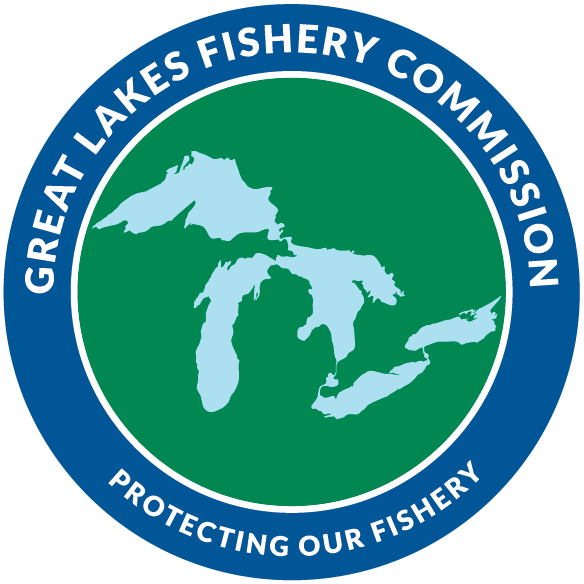Updated 2024-12-11 00:54:04
Lake Huron -> 2.0 Percid (Walleye and Perch) -> Walleye Recruitment and Population Size
Reporting Interval
2018 - 2022
Area
Saginaw Bay
Meeting Target?
Meets
Indicator Trend
Upward trend
Confidence?
Moderate-High
2.1.4. Walleye Recruitment and Modelled Population Size in Saginaw Bay
Recruitment is a measure of all the Walleyes joining the population each year. It can be defined at different ages and life stages. One long term measure is the mean catch rate of fall young-of-the-year or ‘age-0’ walleyes in the annual trawling survey. Walleye in Saginaw Bay have exhibited a regular and robust pattern of recruitment since 2003 (Figure 1) when ecological changes in Lake Huron and Saginaw Bay changed and released the population from limits on reproduction. The primary limit on recruitment in previous years was the predacious and competitive effects of the invasive Alewives whose populations collapsed during 2003 and 2004. Prior to 2003, Walleye recruitment was heavily dependent on Walleye fingerling stocking, Hatchery fish accounted for about 80% of most year classes up until 2003. Walleye stocking was discontinued in 2006 and all walleyes there today are wild (naturally reproduced). Interestingly, there is now a pattern of three strong year classes with one weaker year class between the next series of three strong year classes (Figure 1). This is believed to reflect stock/recruitment dynamics taking place where higher densities of Walleyes are resulting in a weaker year class periodically, then once population size dips, stronger year class production resumes. This classical population pattern has been evident now in Saginaw Bay for two decades. Previously, if a year class showed strong as fall age-0 recruitment events in the trawling data, it showed strongly in subsequent measures such as yearling (age-1s) in the gillnet portion of the annual assessment survey and as age-2 recruits in the SCAA model. More recently this continuity appears to be decoupled and the pattern of strong and weaker year classes appears to be set at later stages. The same phenomenon was documented in lake Erie Walleye when that population first recovered. Nevertheless, mean catch rate of age-0 walleyes remains a useful index of reproductive success.
Currently there is not specific population size target set for the Saginaw Bay Walleye population. The population estimate of the number of walleye aged 2 and older is an output of a statistical-catch-at-age (SCAA) model. Recovery of the population is evident after 2003 (Figure 2). Most striking is the sharp increase in 2021 which is driven mainly by a very strong recruitment of over 5 million age-2 Walleyes (Figure 2). Despite a liberalization of the recreational fishery by the Michigan DNR in 2015, modelled population trends suggest the Saginaw Bay Walleye population has grown in recent years. Liberalization of recreational harvest was intended to more fully utilize the recovered Walleye population and perhaps lead to a reduction in abundance so as to better balance the population with the prey base and to provide for better survival of juvenile Yellow Perch. That reduction in population size was not attained. A new Saginaw Bay Walleye and Yellow Perch management plan is in development and may or may not retain the same objectives and regulation set. One consideration is that the Saginaw Bay Walleye population may not be finished recovering. The full magnitude of recovery may remain to be revealed. Lake Erie’s Walleye population has similarly gone through periods of expansion even after achieving its initial recovery.
Catch-per-unit-effort of age-0 Walleye in Michigan Department of Natural Resources bottom trawl surveys in Saginaw Bay, Lake Huron, 1986-2022.
Statistical-catch-at-age model estimates of age-2+ Walleye abundance in Saginaw Bay, 1986-2022.
Methodology
Walleye recruitment was measured as the mean catch rate of age-0 Walleyes per 10-minute trawl tow. The trawl is a two-seam otter trawl used for all tows had a 10.66-m headrope with 4.6-m wings and 18.9 m overall length and was constructed of 76-, 38-, and 32-mm graded stretched-measure mesh from gape to cod end, with a 9-mm stretched-mesh liner in the cod end. The net was towed along the bottom for 10 minutes by a single warp and 45.7-m bridle at a speed of approximately 2 knots. The trawl survey is based on a stratified-random design (24 total tows/survey) and is conducted in the fall.
Statistical-catch-at-age (SCAA) models were used to estimate the abundance of age-2+ Walleye in Saginaw Bay. The SCAA model is an age-structured model that uses the principles of maximum likelihood estimation to fit model parameters based on comparing observed data to predicted data. The dashed lines reflect error bounds that are two standard errors of the estimate.
Other Resources
Contributing Author(s)
- David Fielder, Jeff Jolley - Michigan Department of Natural Resources
- Chris Davis, Arunas Liskauskas, Stephen James, and Jason Ritchie - Ontario Ministry of Natural Resources and Forestry
- Mike Rucinski - U.S. Fish and Wildlife Service

